What is GHW
The GHW project is included in the objective A area “Renewal and capitalization of distinctive expertise” because it is aimed at improving technical competence (both technological and managerial) of Italian wine businesses for the development and usage of innovative processes on the entire production chain as well as supporting capitalization in order to reach long-lasting competitive development thanks to protection, industrialization and diffusion process.
The project includes Industrial Research and Experimental Development integrated actions merged into an innovative, advanced, technological and organic technological system working with certified standards and which will help Italian wine producers to plan, analyse and control the whole production chain by preserving and improving the nutritional level of the wine, from transportation of raw material in the cellars and up to its eventual use.
The sub-area of the call to which GHW refers to is A5) “Technologies, production systems and products allocated to the improvement of the quality of life (chemistry, biology, nutrition)”.
This analysis and management system is totally web-based, for all company levels and interconnected with other external entities, it can be employed by all interested agents in the Italian wine production chain so as to provide qualitative and quantitative data with standard set terms – by means of special measurements and innovative devices based on detectors, micro organisms, enzymes, software and assisted technology throughout the different processes.
GHW system will be able to develop and improve in time (as a result of artificial intelligence techniques such as neural networks and fuzzy-logic models) offering businesses the correct precautionary or corrective actions so as to guarantee safer products with positive repercussions to health benefit.
The project follows the results of many scientific studies according to which wine, if consumed in the right quantities, contributes to improving the quality of life as it has been proved to reduce the risk of cardiovascular diseases, enhance the immune system, slow down brain ageing and reduce neurodegenerative diseases such as Alzheimer and Parkinson.
It also proves very positive against the Helicobacter pylorus (bacteria responsible for ulcer and possible cause of carcinoma and gastric lymphoma) and, according to recent studies in nutrition genomics, red wine in particular may prevent diabetes and controls cholesterol levels.
Even though the positive effects of wine have been renowned through scientific research it is also true that no business has been able to turn this influence into competitive means on the market, on the contrary it suffered repercussions due to the anti-alcohol campaign which played an important role in reducing general consumption.
Another backlash comes from the regulatory changes introduced with the new OCM on wine (nondescript wine in Northen Europe which lacks a tradition in wine production) thus the “made in Italy” should find innovative means to increase its competitiveness at international level. This could be achieved by following the most promising developments in the food sector comprising the “seven pillars”
of the Italian Food for Life (IF4L) which pinpoint major relevant areas (health, safety, quality) that include the description of research development features and the testing of derivative applications in accordance with market demands.
The GHW project will focus on this, appreciating the most important and valuable aspects of Italian wine that is its quality, intrinsic and perceived, nutritional values, emotional content and the possibility to preserve and communicate the product’s safety and health benefits.
It will do so by researching and developing along the whole production chain solutions based on detectors, organic detectors, antagonist micro organisms, enzymes and the results will merge in real time into an integrated technological system (the “Grape & Health Wine”) which will show the consumer the “best” wine and suggest to businesses when and how to step in to improve the quality of their produce; it will also support them to improve nutritional aspects and food safety (starting with the enhancement of the raw material up to the processing and preservation of the wine) with certification of progress according to quality and traceability standards.
The system could therefore provide information on real and effective nutritional and health values of a specific bottle of wine that has been purchased and would register in the system the consumer’s judgement, the registration on the web platform will be connected to the code quoted on the bottle (counter of chemical-physics data observed during the whole production process).
To sum up the GHW project is aimed at developing innovative technological solutions with the following aspects:
- Development of innovative solutions able to improve the organic availability of specific nutritional components;
- Improvement of organic elements of foodstuffs involved with pathogenic opposition mechanisms;
- Development of innovative elements of foodstuff beneficial for human health;
- Development of innovative solutions for the production of improved enzymes deriving from co-products, sub-products and food remains;
- Nutritional-genomic applied technologies for the development of bioactive components of foodstuffs;
- Application of components which are able to condition cellular control mechanisms both at cognitive and neurological levels.;
Description
The DecaVelta System
It consists in the creation and in time management of an integrated control system of agricultural and industrial activities, relative to the production of wine. This through the monitoring of climatic, pathological, nutritional, and fermentative variables, among others, that affect or could influence the qualitative productive process.
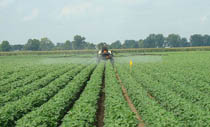
Not only Viticotura
In 2006 DECA SPA created DecaVelta: a revolutionary system that uses Artificial Intelligence for the prediction of diseases in vineyards. Through the use of meteorological sensors and acquisition of data it is able to reduce the use of pesticides and treatments on plants and to prevent diseases by predicting them on time, so as to improve the final quality of the product.
It is important to understand that this system is applicable to all sectors of agriculture and not just that of vineyards, so as to have a complete control of whatever crop one is trying to grow, and to be able to harvest in a more efficient and less costly way, while respecting the environment. Another fundamental aspect of Agriveltha is its tracking ability, through the use of Artificial Neural Networks (ANN) it is able to foresee diseases and detect faults, this obviously resulting in great savings.

The aim of DecaVelta
The primary aim of the project is that of foreseeing the onset of diseases such as downy mildew and powdery mildew, and of limiting the use of pesticides in the cultivation of vineyards, allowing the firms in this sector:
- *to obtain a product that is qualitatively better and quantitatively unaltered
- * to keep those variables that influence the quality and quantity of production under control
- * to optimize plant protection measures by evaluating conditions favorable to the devolpement of pathogens on the basis of which one can decide when to intervene
- * to avoid traditional fixed treatments reducing the number of interventions to a minimum
- * to increase the knowledge in the area of development of diseases related to various types of variables
- * to reduce costs
- * to minimize soil contamination

Immediate Aims
The project aims to achieve the following Aims:
- * Reduction of the use of pesticides Increase of the plants’ response to treatments
- * Improvement of the final quality of the product
- * Reduction of the impact on the environment of the residues of pesticides, and less penalizing treatments for the ground, in case of monocoltures
- * Improvement and optimization of the management of agricultural activities Traceability
- * Traceability

Long Term Aims
Long-term aims can be summarized as the following:
- * Control of other variables (water resources, nutritional,etc.), *extension to other agricultural areas
- * The application of functions of a managing sort (derived from WELCOME2) with the use of avantguarde IT technologies to revolutionize storage philosophies
- * Management and processing of bulks of data; such variables suitably data-processed will allow to carry-out forecasting activities of events.
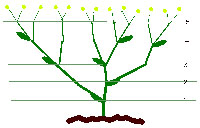
Steps to take
The project intends to pursue the following targets:
- * a prototype of the system for detecting the “downy mildew” pathology
- * the installment of “weather units” for the acquisition of data
- * the application of a forecasting software of “Goidanich” standard
- * predictions by means of the use of artificial neural networks (ANN)
- * verification on the field and in companies that use the data acquisition system and training of the user by remote.
During 2004-2005 the following was accomplished within the project, with the participation of Telecom, Pirelli Labs, Universities and of Research Institutes.
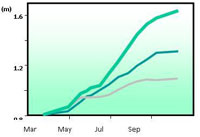
The First Measurable Results
The prototype has allowed in particular the optimization and decrease of the number of anti-downy mildew treatments -Plasmopora Wine- (in the last year from 12 to 7 in the case of development of the disease –Veneto; and from 5 to 1 in the case of absence of the disease – Lazio), with a saving quantifiable between 300/400 Euros per hectare (cost of the product + cost of the distribution).
All this regardless of the minor environmental impact due to the lower dose of the product distributed
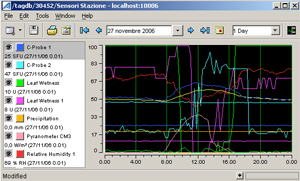
State of the Art
Having concluded its first prototype phase, the DecaVelta project is articulated according to the following by now consolidated elements:- 1. ADCON Telemetry UNITS of radio or GSM type. Such a unit is made-up of a central unit associated with one or more secondary units in relation to the type of vineyard or of orography of the soil.
- 2. The unit allows the monitoring of the following environmental parameters with minimum 15 minutes interval periods: Quantity of precipitation, Soil temperauture, Sun irradiation, Relative humidity of the atmosphere, Wind speed, Direction of the wind, Temperature of the astmosphere, Leaf wetness, Soil humidity at 20cm, Soil humidity at 40cm, Further data services such as: battery charge level, solar panel power supply, and status of the connection.
- 3. Possibility of viewing the parameters via Internet, both through Workstation as well as on Pocket PC connected via GPRS
- 4. Specific Software of data processing information with the main algorithms implemented for the prediction of downy mildew infestation (Goidanich)
- 5. Possibility of exporting sets of data from internet client for further purposes, both in Microsoft Excel and XML format
- 6. As soon as further historical info will be available in the course of the project, revisionary functionalities of diseases based on non-linear models (Neural Network)
Will be implemented The system learns automonously as it accumulates intermediate data results.
Through a rigorous workflow which includes: Data Sending, Data Warehouse, Data Mart, Data Mining & Artificial Intelligence, and Procedures & Field Operations, prediction charts are obtained which assert the services offered.
In the case of the software offered for the prevention of downy mildew infestation, it won’t be complex to interact with the Neural Network since this will provide data exclusively concerning possible risks of infestation. The final user will never have to deal with the complexity of the neural networks.
He/she will exclusively benefit from their predictive abilities. The data can be viewed and/or entered also via Pocket PC.
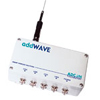
Tools
The technological developments in the field of microeletronics and sensors devices, as well as in the telecommunications technologies, have led the way to interesting applications scenarios for the development of new generation monitoring systems, the so-called Distributed Networks of Sensors. It essentially deals with ad-hoc monitoring networks, conceived for managing even a very high number of sensors, distributed in a very broad but hardly invasive manner (even throughout very extended territories), able to deliver data continuously and in real-time, entirely wireless, with low investment and managing costs.
The main characteristics of the system carried-out by Pirelli – Telecom Italia are:
* Modularity and scalability
* flexibility and operability
* reliability
* real-time data collection and wireless mode
* advanced network functionality (plug&play of sensors, auto reconfigurability, etc...)
This technological platform of general purpose type, can be “specialized” with appropriate sensors, adapting it to various application needs. Thanks to the modular structure the system is furthermore easily updated in anticipation of future upgrades, both at a hardware level as well as of protocols and standards used. The elevated amount of data made available in real-time by these systems, appropriately managed and processed, can enable innovative operating and managing tools (and related services) based on highly valued information. (resulting, for example, from the integration with predictive models and/or decision support).
Application for the Monitoring of Traffic
The state of the art of the hardware for the monitoring of traffic foresees the use of devices such as video cameras, radar, inductive loops, piezoelectric sensors, etc…
These systems generally present high costs and difficulties in set-up, maintenance and management, which in fact prevent a broad circulation consequently limiting even the potential set-backs in terms of quantity and quality of the info connected to them.
The Pirelli/Telecom Italia Systems, combining specially developed innovative sensors to the technology of Distributed Networks, offer the possibility of using systems for the monitoring of traffic able to give back in real-time high quality measures with low costs. Thus enabling to broaden and make more effective the data collection of traffic with positive set-backs in terms of the reliability and efficiency of the models for the forecasting and management of mobility.
Here below the characteristics of the Pirelli Sensors/Telecom Italia system are described in further detail. The proposed system is articulated on three levels:
Level 1 (Sensors/ Actuators)
At the lowest level there are the “wireless sensor nodes”, installed under the road surface (5 cm depth), which allow the detection of the traffic parameters of interest, such as speed, calculation and classification. Technical details:
* Package & Mechanics: Total endurance (IP68), Load resistance (4 Ton)
* Technicalities: Battery power, Wireless data transmission, Advanced radio capabilities (ex: multihopping), Reconfigurable by long duration remote (up to 5 years)
* Functional: Wireless & Real-time Monitoring, Vehicles Count, Speed measurement, Classification
Level 2 (Unit/Gateway)
The data of the sensors is transmmited in a wireless and real-time mode to a roadside control unit, which covers various functions: it coordinates and manages the sensors, acting as an access point (with the possibility of a further processing of the same data) allowing long range transmission, always in real-time. It further offers the possibility of integrating practically any type of sensors used for various purposes (parameters of climate, safety, pollution, etc…) Technical Details:
* GPRS or Ethernet Connections
* Reconfigurable by Remote or via local server
* Short and long range Wireless
* Advanced radio capabilities (Network coordinator LAN)
* Back-up batteries with the possibility of solar panel power supply or network, of 220 V
Functional Details:
* Short range/long range Gateway
* Access Point/Sensors Hub
* Management of network synchronicity for real-time applications
* Management of Plug&Play sensors
Level 3 (Network Manager)
Software for managing the distributed network. It handles the network of units and sensors and coordinates the gathering, archiving, and validation of data in the relative database. It offers the possibility of access to external clients (via Web), implementing the levels of safety and of management of the services offered to accredited Clients. Finally it also implements the administration software which allows the fully remote management for regular and extra maintenance (for example software upgrade). This software can be integrated in already existing management structures (ex: operative units) rather than being installed independently on a PC. The level of integration used allows the implementation of a high number of vertical applications utilizing the “general purpose” platform, and exclusively specializing it at a sensor system level or dedicated software. This gives the possibility of having a sole integrated system of control and multifunctional management, with low investment and management costs.
Artificial Intelliegence based on Neural Networks
In the context of cooperation with TELECOM Italia SpA, D.E.C.A. has carried out the IT system of Data Management and Data Analysis described below: The DecaVelta project is based on innovative technologies of information processing that result from Artificial Intelligence studies. Artificial Neural Networks (ANN) in particular are widely used, the software is able to process in a non-linear way large amounts of information producing models of adaption stimulus-response that accomplish predictive models of complex phenomena. Such models are applied to foresee in an efficient manner the onset of plant diseases, reducing and rationalizing the use of treatments. The lowest environmental impact that results from it, besides the considerable lesser impact on the ecosystem, determines a greater economic return for companies given the lower expenditure, and a better quality and health of the product , resulting in an actual certification chain of highest profile. ANNs were created to simulate the neural structure of the human brain, imitating the known mechanisms of learning, predominantly on an experimental basis. The most frequent use of ANNs is the supervised learning. On the basis of the processing of a data set compared to a specific output, it’s possible to correct the parameters of the model to find relations between the data and thus generate the correct output value, by means of parallel computational operations. In this way they are able to deduct quite efficient rules to solve predictive-type problems. ANNs are non-linear mathematic models by definition, but contrary to techniques such as non-linear regression they don’t carry out any type of hypothesis on the form of data; instead they are indipendently able to identify interactions between variables which need to be explicitly specified in models of statistic regression. ANNs are thus appropriate for analyzing an objective/event variable in the context of a strong non-linearity of incoming data (or of inputs).
Main pubblications on the Project
A Neural Network-Based Forecasting Model for Plasmopara viticola infection also allows to manage changes introduced by the new climate scenario: a two years study (R. Bugliosi, G. Spera, A. La Torre, L. Campoli) Congrès sur le Climat et la Viticulture - Zaragoza (ES) - 10-14 April 2007 Advanced use of Artificial Intelligence Techniques on Viticulture for the reduction of the use of Plant Protection Products. Achievement of a Forecasting Model for Plasmopara Viticola Infection (R. Bugliosi, G. Spera, A. La Torre, L. Campoli) XXIX World Congress of Wine and Vine, Logroño, Spain, June 2006 Artificial Intelligence approach with the use of Artificial Neural Networks for the creation of a forecasting model of Plasmopara vitivola infection (R. Bugliosi, G. Spera, A. La Torre, L. Campoli, M. Scaglione) 58th International Symposium on Crop Protection, Gent, Belgium, May 2006
Borgo Scopeto
 Borgo Scopeto carries out an activity that aims at obtaining top quality products, achieved by meticulous productive and artisanal-type techniques; however, it reveals a modern mentality in management, efficient and competent in marketing relations. More than thiry years have gone by since the first vineyards and the first wine cellar experiences. Borgo Scopeto, whilst growing in the respect of the Chianti Classico tradition and of the various terroirs of the area, was able to exalt its wines with a creative spirit and desire for innovation, expressing the most rigorous quality. For this very reason, Borgo Scopeto wines have been adopted by some of the most famous restaurants in the world, and have been served at international meetings and at official State dinners.
Borgo Scopeto carries out an activity that aims at obtaining top quality products, achieved by meticulous productive and artisanal-type techniques; however, it reveals a modern mentality in management, efficient and competent in marketing relations. More than thiry years have gone by since the first vineyards and the first wine cellar experiences. Borgo Scopeto, whilst growing in the respect of the Chianti Classico tradition and of the various terroirs of the area, was able to exalt its wines with a creative spirit and desire for innovation, expressing the most rigorous quality. For this very reason, Borgo Scopeto wines have been adopted by some of the most famous restaurants in the world, and have been served at international meetings and at official State dinners.
Bossi Fedrigotti
 The company is located in Rovereto, it’s made-up of 40 hectares of vineyards divided into three main estates on each side of the Adige, that is to say Maso San Giorgio (Rovereto), Fojaneghe (Isera e Mori) and Sant'Antonio (Pomarolo). The land on which our vineyards grow goes from basaltic of vulcanic origin to calcareous morainic to the alluvial valley bottom, according to a range of truly unique features. The vineyards, both those of red fruits such as Cabernet Frank and Sauvignon, Merlot, Teroldego and Marzemino, as those of white fruit such as Chardonnay, aromatic Traminer, Pinot grigio and Moscato giallo, are mainly cultivated following the Trentino pergola (trellis) system.
The company is located in Rovereto, it’s made-up of 40 hectares of vineyards divided into three main estates on each side of the Adige, that is to say Maso San Giorgio (Rovereto), Fojaneghe (Isera e Mori) and Sant'Antonio (Pomarolo). The land on which our vineyards grow goes from basaltic of vulcanic origin to calcareous morainic to the alluvial valley bottom, according to a range of truly unique features. The vineyards, both those of red fruits such as Cabernet Frank and Sauvignon, Merlot, Teroldego and Marzemino, as those of white fruit such as Chardonnay, aromatic Traminer, Pinot grigio and Moscato giallo, are mainly cultivated following the Trentino pergola (trellis) system.
Cantina Cerveteri

Cantina Cerveteri is a Cooperative made-up by about 750 families of wine growers, and it represents a reality of huge socio-economic importance for the Lazio Region. Founded in 1961, operating for the then Ente Maremma, in few years of activity it created a quality brand conquering relevant areas in the regional wine market, both domestic and foreign.
Cantine Co.Pro.Vi.

In 1950 in the town of Velletri, important wine center of the Lazio region, and more specifically in the Castelli Romani area, the company Co.Pro.Vi. was founded - Consorzio Produttori Vini di Velletri (= “Wine Producers Consortium of Velletri”). Since both the founding and the development of Co.Pro.Vi. are closely linked to the origins and historical events of Velletri’s viticulture, it’s necessary and a must to mention such events even if briefly, to better comprehend the importance that the Co.Pro.Vi. Company has had and still has regarding the marketing of the “Velletri” and “Castelli Romani” d.o.c wines, on both domestic and international markets.
Donnafugata
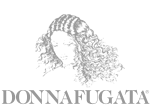 Donnafugata was founded in Sicily by a family that has always believed in the extraordinary wine potentialities of this regions’ soils, and which counts 150 years of experience in quality wines. Giacomo Rallo and his wife Gabriella, convinced that to be able to grow and improve one must always be open to changes, in 1983 gave life to a new productive project: Donnafugata. An adventure which starts in the historical family wine cellars of Marsala and from the vineyards of Contessa Entellina, in the heart of Western Sicily; to reach the island of Pantelleria as well. Alongside the parents are the children Josè and Antonio, and so the company increases the pace on the road to Extreme Quality: a project which aims at caring for details, giving rise to business decisions which pursue always more advanced targets. And for the future? Young Gabriella and Ferdinando are already undergoing a “full immersion” in the family grapes.
Donnafugata was founded in Sicily by a family that has always believed in the extraordinary wine potentialities of this regions’ soils, and which counts 150 years of experience in quality wines. Giacomo Rallo and his wife Gabriella, convinced that to be able to grow and improve one must always be open to changes, in 1983 gave life to a new productive project: Donnafugata. An adventure which starts in the historical family wine cellars of Marsala and from the vineyards of Contessa Entellina, in the heart of Western Sicily; to reach the island of Pantelleria as well. Alongside the parents are the children Josè and Antonio, and so the company increases the pace on the road to Extreme Quality: a project which aims at caring for details, giving rise to business decisions which pursue always more advanced targets. And for the future? Young Gabriella and Ferdinando are already undergoing a “full immersion” in the family grapes.
Due Antichi Casali - Pinci

On 21 hectares of vineyard, in the municipality of Albano Laziale and Marino, the vines of D.O.C. Colli Albani and D.O.C. Castelli Romani are cultivated; 10 types of vines are present in the company: Malvasia of Candia, Malvasia of Lazio, Bellone, Greco, Montepulciano, Sangiovese, Merlot, Cabernet Sauvignon, and Chardonnay. The grapes which are collected in full ripening are made to ferment after a light pressing. The careful wine cellar operations, and the cold stabilization contribute to the production of a direct wine, refined and full of flavour.
Grotta del Sole

In 1992 the Martusciello family decided to launch a real “wine archeology” task, to rediscover and exalt certain nearly forgotten ancient native vines, such as the Falanghina and the Piedirosso of Campi Flegrei, the Asprinio of Agro Aversano, the Gragnano and Lettere.
Mezzacorona

Founded in 1904, it’s one of the first associations of producers created in Italy. It includes 2,400 hectares of vineyards (in Trentino and in Alto Adige), for an annual production of 300,000 quintals of grapes. All of the vineyards are cultivated following an “integrated production” system, whose aim is to obtain always more natural products, in respect of the biological balance of nature.
Moncaro

Moncaro has always characterized itself for its strong roots to the territory of the Marche Region and its environment. It’s perhaps because of this that Moncaro feels like the cultural expression of the Marche: because it’s located in the heart of the region and it represents the very heart. As in other realities of this Earth, there is the strong desire and the will to finally reveal the beauties and goods of its products. Moncaro believes it: there must be a way to become known, speaking to the world without “screaming”: producing quality and service, but with personality and style.
Terredora

Since 1978 Terredora is the protagonist of the wine-growing Renaissance in Campania. Introducing in the millenarian native vine cultivations modern innovations , technical knowledge and men oriented towards enhancing its future, the company has promoted the return to Campanian viticulture at its most ancient and qualified tradition. With 120 hectares of owned vineyards, Terredora is today the most important and extended vineyard business in the region of Campania, using the most careful breeding techniques and under the costant research for the perfect balance with the environment.
Tizzano
 The Tizzano Farm extends over 230 hectares, of which 35 are of specialized vineyard, on the Bolognese hills above Casalecchio di Reno. Its soil, facing south and of dry climate, sunny and ventilated make the optimal elements of these hills for the cultivation of vines, which was surely already practiced back in the 1500s, and probably even from the time of the Romans, as evidenced by the "Naturalis Historia“ by Plinio il Vecchio (Plinio the Old). In the middle of a vast and luxuriant park within the Company Villa, is found Marescalchi, the centuries old residence of a noble and distinguished Bolognese family, who shared strong ties with France. Appropriate wineries for the preservation and aging in wood were set-up. Today the Visconti di Modrone brothers, heirs of the Marescalchi family, with modern criteria but still linked to tradition, run the agricultural and wine activities with the cooperation of Mr. Gabriele Forni and the consultation of Giambattista Zanchetta. The traditional french vineyards as the native Pignoletto vineyard, are meticulously cared for, the vintage operations are carried-out by hand whilst the more advanced techniques of processing of grapes allow the achievement of a result of great quality and prestige.
The Tizzano Farm extends over 230 hectares, of which 35 are of specialized vineyard, on the Bolognese hills above Casalecchio di Reno. Its soil, facing south and of dry climate, sunny and ventilated make the optimal elements of these hills for the cultivation of vines, which was surely already practiced back in the 1500s, and probably even from the time of the Romans, as evidenced by the "Naturalis Historia“ by Plinio il Vecchio (Plinio the Old). In the middle of a vast and luxuriant park within the Company Villa, is found Marescalchi, the centuries old residence of a noble and distinguished Bolognese family, who shared strong ties with France. Appropriate wineries for the preservation and aging in wood were set-up. Today the Visconti di Modrone brothers, heirs of the Marescalchi family, with modern criteria but still linked to tradition, run the agricultural and wine activities with the cooperation of Mr. Gabriele Forni and the consultation of Giambattista Zanchetta. The traditional french vineyards as the native Pignoletto vineyard, are meticulously cared for, the vintage operations are carried-out by hand whilst the more advanced techniques of processing of grapes allow the achievement of a result of great quality and prestige.
Torre Gaia

Torre Gaia is one of the most important regional realities of the wine growing sector. Founded at the beginning of the 1900s by Dr. Federico Perlingieri who formed one of the first Company Capitals of the province of Benevento: the Agricola Sannite S.p.a. Company, which is still today the owner of the estate. The Company is located in Dugenta, province of Benevento, and it extends for about 113 hectares contained within the territory of Sannio Beneventano, in an area of ancient wine-growing tradition.
Vigna S.Elena

In 1997 the Gozzi family comes into contact with the Sant'Elena Vineyard following the consultancy started with the Basiliani Monks of the Abbey Greca (of San Nilo in Grottaferrata) by the father of the owner, the Agronomist Dr. Annibale Gozzi, who only six years later will decide to rent it. The Sant'Elena Vineyard extends over a total of Ha 19.11.00 in a sole body of land subdivided into several homogeneous plots from a cultural point of view.
Presentation of AgriVeltha at Enovitis 2007
13-17 November 2007 - Milan, Enovitis
Presentation of AgriVeltha at the SMAU 2007
•17-20 October 2007 - SMAU Fair
Conference: Agriveltha “High technology and telecommunications for the battle against phytopathologies of the vine”
March 31st 2007, 09.00/13.00 - Vinitaly
Vinitaly
•29th March – April 2° 2007
Comm, Appl. Biol. Sci. 2006, Ghent University, Vol 71 (3a) -2006, 859-865
Development of non linear forecasting model of Plasmopara viticola infections using Artifìcial Neural Networks. BUGLIOSI R., SPERA G., LA TORRE Anna, CAMPOLI L., SCAGLIONE M.
5th Int. Workshop on Grapevie Downy and Powdery Mildew. S. Michele all'Adige, Italy, 18-23 June 2006
Development of non linear forecasting model of Plasmopara viticola infections using Artifìcial Neural Networks SPERA G., LA TORRE Anna, CAMPOLI L., BUGLIOSI R., SCAGLIONE M.
XXIXth World Congress of Vine and Wine. OIV 2006 Spain, Logroño 25-30 June 2007
Advanced use of Artificial Intelligenc Ttechniques on viticulture for the reduction of protection products use. Realization of a forecasting simulation model for Plasmopara viticola infection SPERA G., LA TORRE Anna, BUGLIOSI R., CAMPOLI L., SCAGLIONE M.
Climate and Viticulture Congress - 2007, España, Zaragozza 10 - 14 April 2007
A Neural Network based forecasting model for Plasmopara viticola infection allows also to manage changes introduced by the new climate scenario: a two years study BUGLIOSI R., SPERA G., LA TORRE ANNA, CAMPOLI L.
Comm, Appl. Biol. Sci. 2007, Ghent University, Vol 72/2 -2007, 321-325
A two years study results in the use of artificial neural networks to forecast Plasmopara viticola infection in viticulture BUGLIOSI R., SPERA G., LA TORRE A., CAMPOLI L., GIANFERRO M., TALOCCI S.
XVth International Symposium GESCO 2007 Croatia, Porec 20-23 June 2007, 1115-1123
Results of a two years trials of a new forecasting model for Plasmopara viticola infection realized with an artificial neural network 2) SPERA G., BUGLIOSI R., LA TORRE ANNA, CAMPOLI L., GIANFERRO MARIKA
They say about us…
-
Here the wine healthy!
april, 16, 2017 - Onios - HiTech -
Hello ? Yes, it’s the vineyard speaking…
8 aprile 2006 - Italia Oggi -
Here ’ s hi-tech wine: The computer knows everything about it
8 aprile 2006 - Il Giornale -
Hi-Tech Wine. A Telecom System
9 aprile 2006 - Il Tirreno -
Telecom unit launches SOS parassites
27 aprile 2006 - Il Sole 24 Ore -
Wine-making Sensors
8 aprile 2006 - Il Denaro -
The Trentino wine-making tradition comes together with the most advanced technology
10 aprile 2006 - Cantina Bossi Fedrigotti, Comunicato Stampa -
•Telecom Italia Helps in Wine-making
10 aprile 2006 - Arena -
•Telecom. Wine is better when hi-tech
8 aprile 2006 - Affari Italiani -
Various Agencies
7 aprile 2006 -
Technology can foresee downy mildew
www.cedra.it -
•Bossi Fedrigotti, Tuscan Window – Technology against pesticides
18 novembre 2005 - Corriere del Trentino -
•Revolution in the fields: Thanks to computers only half the poisons in vines
21 giugno 2006 - Trentino, Corriere delle Alpi -
Hello, who’s speaking? Downy mildew
marzo, aprile 2007 - capita AL vino -
•The unit that learns from Downy Mildew
marzo, luglio 2008 - Millevigne


